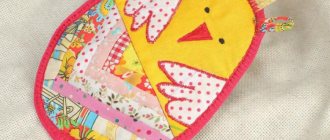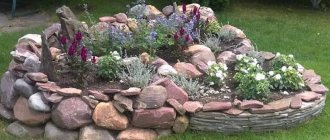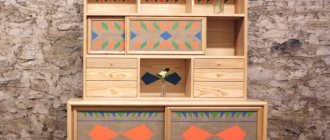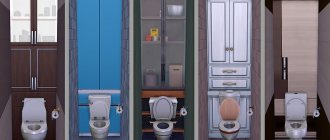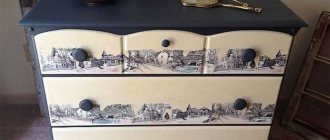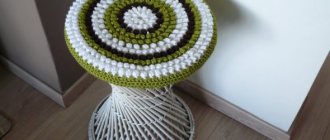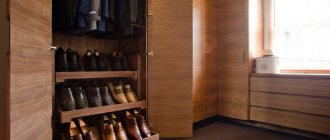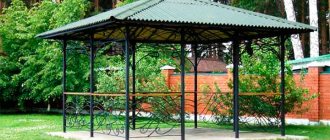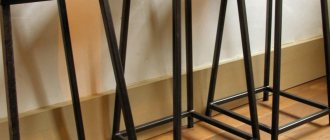Anyone can make a chair for their garden with their own hands! The reason for such optimism is the absence of strict restrictions and the variety of structural and design solutions. Garden furniture, like no other, provides enormous scope for bringing your ideas about beauty to life.
To build a chair, it is not necessary to use first-class wood; improvised materials are often used (cable reels, pallets, etc.). Even if your hands have never held anything heavier than a fountain pen, they will certainly reach for the tool. After all, it’s hard to resist temptation when looking at simple and affordable solutions for furnishing a summer house. Moreover, you don’t need to blindly copy them: modify the designs, do amazing and unique things, be original.
Required Tools
To make a chair you will need a set of the following tools:
- Hand or electric saw;
- Hammer;
- Screwdriver;
- Electric or manual jigsaw;
- Chisel;
- Electric or manual plane;
- Mallet;
- Grinder;
- Furniture stapler;
- Clamps;
- Angle ruler;
- Yardstick.
How to make a folding chair: drawings, photos
We make a folding chair with our own hands.
Folding chairs are very compact, they are easy to open and fold, while they take up minimal space and do not clutter up the space in the room.
A folding chair will always be useful at home, in the country, on a picnic; a folding chair is indispensable when fishing; when folded, it is easy to carry in your hand.
You can make a folding chair with your own hands, in this article we will take a closer look at how to make a folding chair and stool with your own hands. First, let's take a look at the pictures.
Drawing of a folding chair.
Different design, identical design, only size difference.
And this is what the folding chair itself looks like.
The chair folds up.
Materials and tools for making a folding chair.
To make a chair, it is advisable to use hardwood, such a chair will last a long time, but hardwood is heavier, it is optimal to make a chair from pine, it is more flexible in processing, and the chair will become much lighter.
So, to make a folding chair we will need the following materials:
- Rods 470 x 40 x 20 mm. - 4 things. (legs).
- Rods 320 x 40 x 20 - 4 pcs. (bars under the seat).
- Rods 320 x 40 x 20 - 2 pcs. (legs).
- Rods 350 x 60 x 20 - 4 pcs. (sitting).
- Bolts 6 x 40 mm - 6 pcs.
- Self-tapping screws - 45 mm.
You will also need a standard set of tools for working with wood:
- Hacksaw for metal.
- Airplane.
- Chisel.
- Drill, countersink drill.
- Phillips screwdriver.
- Sandpaper.
- Square, tape measure, pencil.
How to make a folding chair with your own hands.
Let's start making the chair. We will prepare the bars according to the dimensions provided; all the bars need to be treated with sandpaper, burrs removed, and sharp edges smoothed.
We connect each pair of chair legs along the axis with bolts; when installing the heads of the bolts and nuts, a flush recess is necessary; for this hole we additionally countersink.
The difference between a chair and a stool
A classic chair consists of legs, a seat and a back. The stool has no back - this is its main difference.
Stools can be used everywhere: At home, outdoors and in the garage.
A chair is, first and foremost, a home furnishing item. Moreover, as decoration, beautifully crafted chairs can decorate any room.
Step-by-step creation of a wooden chair for a summer house with your own hands
For connection, as I wrote earlier, we will use screws in the same style.
I break the connection of parts into the following steps:
- Looking at the drawings, photos, videos, I put the parts next to each other and fix the joints on them.
- At the marks, we drill holes with a wood drill with a diameter of 2.5 mm for the length of the screws in our case, 30 mm.
- We widen the holes using 8 mm. drills 5-10 mm into the jaw.
- We screw in the screws with a regular screwdriver or if you have a screwdriver, use it.
- We bring beauty - with the help of glue and pants.
- The glue has dried, which means it’s time to remove the protruding part.
Step-by-step video instructions for making a chair for your garden
Do-it-yourself wooden chair
Do not neglect drilling, even if you have a good screwdriver, since when screwing in a screwdriver without a hole, the part may move or crack and all the labor and material will go to waste. Pants that will stick out from the chair can also be sanded to the level of the seat or back.
After the final assembly of the garden chair, all that remains is to carry out the decorative finishing. To do this, I advise you to use wood stain or matte varnishes.
Wood selection
Wood for making chairs can be hard or soft. The first type of wood includes: beeches, oaks, birches, maples, walnuts, cherries. Such options have good strength characteristics and retain their shape when deformed.
The service life of such wood is measured in tens of years, but the process itself seems more labor-intensive due to the density of the material. Also, the high cost of wood requires more careful and lengthy work.
- Softwoods include alder, spruce, pine, linden and aspen. They have lower strength characteristics and are less resistant to scratches and chips.
- But there is also an advantage - they are much easier to process. You can easily do the following operations with them: cutting grooves, sawing, gluing and polishing.
- And soft wood costs an order of magnitude less than hard wood. There are types of trees that it is better not to handle with your own hands.
- These include yew, acacia and boxwood - these are all trees that have a particularly durable species.
For the manufacture of chairs, timber 60x40 or 40x40mm is usually chosen. Also suitable are boards whose thickness is 10-15 mm. You can use a small diameter log to cut boards using an angle grinder and an electric saw.
In the process of selecting a workpiece, it is necessary to check its quality. The wood must be dry, smooth, without cracks or chips, and also have the correct shape. Wood blanks are coated with a special antiseptic to increase the moisture resistance of the material.
Let's summarize - the cost of a homemade chair
If you use the minimum set of tools that we talked about initially, you will spend about 8 hours preparing all the parts and connecting them. But if you have a more or less advanced tool, the time can be reduced to 4 hours.
Cost of materials:
A board and beam for one chair will cost you about 500-800 rubles. Consumables (sandpaper and glue) - 100 rubles. Marilka or varnish - 150-300 rub.
Of course, it’s not realistic to buy wooden chairs in a store for that kind of money, but it’s up to everyone to decide what’s more important to you: your time or money.
Types of chairs
There are many types of chairs. We will look at two of them: a kitchen chair for dining and a living room option. They both have a similar shape, but the dining chair has a narrower seat.
The following materials are used to produce chairs:
- Metal blanks;
- Wood;
- Polyamides;
- Composite materials.
There are special versions of chairs made of glass or rare stone. Such designs have, first of all, decorative value.
Of the above materials, the most practical is wood - it is easy to process, has high strength characteristics and looks aesthetically pleasing.
We sit comfortably, with a backrest
Homemade country chairs, made with creativity and taste, can be very different from the samples given here. Blind copying is not required, the main thing is to understand the required proportions, assembly principle and design features of the selected model.
Fig. 11. Standard chair
Fig. 12. Chair assembly
The chair frame (without the seat) is assembled twice, rough (without wedges, dry) and finally. Assembly begins with the “apron” (rear legs, rear, longitudinal drawer), after which the front part is connected to it.
A garden chair can have a solid or stacked rigid back, the elements are attached to spikes. For the sake of aesthetic appeal, connections with open and through tenons are rarely used. Bolts, confirmations, and self-tapping screws are also rarely used. Nails are not used under any circumstances.
Fig. 13. Making a groove for a furniture tenon
Summer residents often opt for folding chairs, which take up little space when folded. In this connection, the home craftsman should be protected from an unsuccessful design that is still in circulation.
Fig. 14. Not a recommended folding chair model. Due to the huge overhang of the seat forward, stability is disrupted; sitting on the edge of a chair, it’s easy to find yourself on the ground
Fig. 15. Designs of folding chairs for the garden
Fig. 16. Garden chair
Design differences
Models with complex shapes are unlikely to be suitable for making chairs yourself. At home, it is quite possible to make a wooden chair of a simple design.
For its production you will need the following elements:
- The presence of two front and hind legs;
- Four drawers for secure fastening of the seat;
- Four connecting strips for securing the legs;
- Seat;
- The back of the chair.
Slats and drawers can be used in large quantities if you think that the chair will not have enough stability. The main disadvantage of the model is its simplicity. Against the backdrop of a beautifully decorated room, an ordinary-shaped chair will fall out of its interior.
Materials
So let’s look at the necessary materials for the manufacture of the planned product:
- Pine board - thickness 25-30 mm, width 140 mm.
- We will make the lintels from square wooden beams - 50 by 50 mm. (you can, of course, also use a board, but the aesthetic component and strength will be lost).
To connect the parts you will need:
- Self-tapping screws - 30 mm long.
- Wood glue.
- Furniture rods - 8 mm (will be used to disguise fasteners).
Amount of materials needed to make a wooden chair with a back (when using timber):
- Board - 5 m.
- Beam - 2.5 m.
- Self-tapping screws - 60 pcs.
- Pants - 20 pcs.
I did not take into account carpenter's glue since most often it is already available and in our work we need a little to secure the rods. As long as you glue all the joints of the chair for reliability, you will need no more than 100 grams of glue.
Video of making a country chair from wood
DIY country chair
Making your own chair
Any production begins with a drawing. Even the simplest sample requires a scheme according to which the necessary parts will be produced. When the sketch of the model has been created and thought out, wooden blanks of the required sizes are cut.
- The dimensions of all prefabricated units must be maintained with an error of no more than 1 mm.
- Otherwise you will have to do extra work with a file.
- Let's take the standard dimensions of the chair (LxWxH) - 500x410x900mm.
Preparation of assembly units
After making the bars of the required dimensions, you need to make grooves in them into which the connecting elements will fit. These grooves can be made with a hand router, having previously marked in which places the recesses will be cut.
The surface in the area of the resulting grooves must be cleaned with a file and then sanded. Also, on all wooden surfaces, right corners are rounded.
Making a soft seat
After you have cut out a piece of plywood of the required thickness, you need to put it on a piece of foam rubber and trim the latter, leaving 1-1.5 cm around the edges.
- Then cover the seat with fabric around the perimeter with an extension of another 5-6 cm.
- Glue the plywood to the foam rubber with a special glue, and then cover the seat blank with fabric and fasten it with a furniture stapler.
- Drive the staples at a distance of no more than 1 cm to avoid swelling.
To begin with, four staples are attached in the center of the surface, and then staples are placed in other directions. After the fabric is tightly secured, its excess sections are cut off with scissors.
Chair assembly
It is done in the following order:
- Lubricate the place where the front drawer is attached with glue and attach it to the front legs of the chair, using a clamp for reliable fixation;
- Glue the back drawer and back in a similar way and attach it to the rear legs of the model;
- Wait a while for the glue to dry;
- After drying, attach the soft seat and connecting strips to complement the fastening of the legs;
- The finished model should be turned upside down to dry completely.
Final work
After the chair is ready, you need to look again at all the surfaces and joints. Excess burrs are carefully cleaned off, and all sharp corners are rounded. The holes for the screws are filled with putty, and the entire structure is covered with bioprotection for wood.
The final operation is to coat the chair with varnish in 2 layers; if desired, you can coat the product with enamel.
Let's start with the basics: making a stool
Fig.1. Samples of stools
Assembling a simple wooden stool is no more difficult than putting together a box. In Figure 1, position 1 shows the classic design, pos. 2 – the same, but artistically decorated. Pos. 3-8 are lightweight stools in which the legs are attached to sockets in a durable thickened seat or to sockets created by side gussets. The greatest strength and comfort for a seated person is achieved by using an X-shaped tie system (item 8).
Fig.2. Construction of a simple stool
Fig.3. The drawer is the main structural element, along with the legs and prongs. For its fastening, tenon joints, bolts and ties can be used. Serves to support the seat and connect the legs. The figure shows options for the design of the drawers. Position 1 shows a stool with legs in sockets.
To prevent the legs of a lightweight stool from breaking off, they must be slightly moved outward from the axis of symmetry (by 7-12°) or bent in an arc and expanded upward. To trim the heels and heads of the legs to the desired angle, the workpieces are tightly clamped and cut in 1 pass. It is very difficult to achieve the required accuracy with further adjustment.
Stool designs that are easy to manufacture
Positions 9 and 10 of Figure 1 show heavy, material-intensive, but very durable stool-pedestals. They are easy to make, so we pay attention to these designs for beginners.
Fig.4. Drawings of heavy stools
The picture above shows different types of heavy stools. On the right, the cabinet parts cut into half the tree (the groove for cutting is not shown). The shape of the seats is centrally symmetrical, fastening is on dowels. If you use soft covers on round stools, they will be indistinguishable from more labor-intensive poufs.
Fig.5. Drawings of panel stools made of 4 parts
Panel (box-shaped) stools are lighter in weight, more comfortable, and require the use of only 4 parts. Assembling them is not difficult, all connections are on dowels, the structures can be extended in length until they turn into a bench. The height of the stools, as can be seen from the drawings, can be different, depending on the needs: for children, for household needs, for the room.
Fig.6. Scheme of a reinforced utility stool. To give an attractive appearance, the sidewalls can be veneered, as shown in position c. The design is ideal for a country house and garden: simple, lightweight, inexpensive to manufacture, looks good, durable and convenient.
Other stool models
Positions 13-14 of Figure 1 show stools similar in appearance to box stools, but mounted on 4 wide flat legs. Similar designs are made with plank or cobblestone sides; the legs are fastened with one leg, located so as not to interfere with the legs.
Positions 15-16 represent step stools with X-shaped legs. To give them the required strength, 2 mutually perpendicular drawers and 2 prongs (item 15) or 4 drawer-beams are used, forming the upper frame, as well as a tie between the crosses (item 16).
Fig.7. Folding stool: drawing, folding method
Positions 17-20 present creative designs of stools in different styles. We recommend the execution of such structures after mastering the initial carpentry skills. The designs of the stools are quite flexible, tolerant of changes in the configuration of parts, and therefore provide scope for the implementation of original creative ideas.
Do not use soft, easily rotting wood for country furniture; avoid poplar, aspen, willow, and alder. To make the seat, it is permissible to use pine or spruce, but the entire structure can also be made from hardwood: birch, oak, maple, beech.
Methods for joining wooden parts
Making a chair for a summer house with your own hands from wood will require the ability to assemble elements:
- insert into half a tree;
- tongue-and-groove connection;
- tongue-and-groove connection;
- connection with dowels.
Fig.8. Inset into half a tree, 1 – closed connection (cross), 2 – open (corner), 3 – blind (half-closed) for insertion on the purlin, 4 – connection along the edge (support for a stool-cabinet).
The connection shown in the figure above is the simplest, but it is quite reliable with additional fastening with dowels, bolts, screws, nails (2-3 per connection). Strengthens the structure and sizing. The procedure for working with a hand tool is as follows: a cut is made along the edges of the recess (leaving 0.5-1 mm to the required depth), all excess is cleaned out with a chisel. Making deeper cuts to knock out an array with one blow is considered a manufacturing defect.
Fig.9. Tongue-and-tongue joints and tenon-groove: 1 – open single tongue-and-groove, 2 – open double, 3 – closed, 4 – tongue-and-groove
The tongue-and-groove joints shown in positions 1-3 are strong enough with one attachment point, or even without it, only with gluing. It is more difficult to make a closed connection (it will require a long period of careful gouging out of the array drilled along the edges), but it will be more reliable and durable.
The tongue-and-groove connection is mechanically similar to the tongue-and-groove connection; they are often mistaken for one another. However, the shoulder of the spike goes around it on all sides, which is radically different from the design of the ridge. Such a connection is permanent, very strong and does not require additional fastenings other than glue.
Fig. 10. Connection on dowels: 1 – marking the end, 2 – drilling holes in the end, 3 – marking, drilling holes in the face and connecting
Dowels are round or octagonal tenons made of hardwood, which are made separately from the elements being connected. Dowels that are wedged during assembly are called dowels; such connections are strong, reliable, and inseparable.
Photo of a homemade high chair
Let's start manufacturing: marking features
To make all the details look neat, you must first round the corners of the legs and supporting elements. To do this, we make markings. We move it away from the end to a distance equal to the width of the slats, and draw a line perpendicular to the slats, after which we divide it in half. Now we have the center of the circle, the radius of which is equal to its width (in our case it is 40 mm). It needs to be drawn, because it is on it that the corners need to be removed from the blanks. Perhaps in words it looks a little sloppy, but by looking at the photo example, you will immediately understand what I am talking about.
This is what the marks on the legs and support bars should look like (40 × 20 × 320 mm)
Here it is worth paying attention to the fact that if on the legs (they are long) such markings are made only on the top, then on the support rails both sides are processed in this way.
The marks I made are not just for uniform rounding of parts. It is in the center of the circle that a hole for the bolt will be drilled, from which a movable hinge will be obtained.
Connecting the support slats to the legs of a folding chair
The first step was to make a hole in the support bar and leg. After that I removed them using a bolt. This was a temporary measure, so I didn't go into detail about the bolts - that can be done later. Due to the fact that I did all the work by trial and error, without yet knowing what the result would be, this was necessary.
The support rail was screwed to the leg
We combine the legs crosswise
Having figured out what to do next, I drilled the second support rail. The second leg was also punctured. Once I was sure I was on the right track, I decided to fully assemble one of the double chair legs with a second support bar that I pulled up with a clamp. I was pleased with the result. There remained the problem of the length between the crossed legs, which would ensure the stability of the chair when open. But this problem was resolved quickly. Crossing the legs of the stool, I placed it on the ground, positioning it so that the distance above and below was the same. It became clear that the required length before joining should be 215 mm. Finally, when the folding chair was assembled, I realized that I was right.
We measure the required 215 mm and make a hole in the center
All that remains is to connect the legs in the drilled places with a bolt. The loop is good. At this point I haven't pressed the bolts flush with the wood yet. Despite the fact that up to this point everything went as it should, you should always be prepared for the fact that all connections will have to be disassembled, which means there is no need to rush with such things.
The legs are fixed with a bolt, which should not fit into the tree yet
Now I could begin a job that I hadn't fully thought about: connecting the two legs to create a piece of furniture.
Criteria for choosing country furniture
Before you start making garden furniture with your own hands, you should choose the material and type of construction.
But first you need to determine for yourself what requirements the future product must meet. The most basic characteristic properties of country furniture are convenience, reliability and durability. After all, we want to relax in nature, completely relaxing in a comfortable chair, and not experience discomfort and worry about the safety of children or house guests, right?
Natural wood is an ideal material for the manufacture of any furniture, including those that will decorate the interior or exterior of a country house. Therefore, if you want all pieces of country furniture to fit harmoniously into the landscape, you should make a choice in its favor. Moreover, it is not necessary to buy this by no means cheap material, but to use improvised means, such as, for example, old boxes, wooden pallets, wooden chairs that have become unusable, windows and doors that have served their time, as well as slats, bars, boards and etc. Show creativity using branches, trunks and even tree roots, and this will help you create unique masterpieces for your home.

